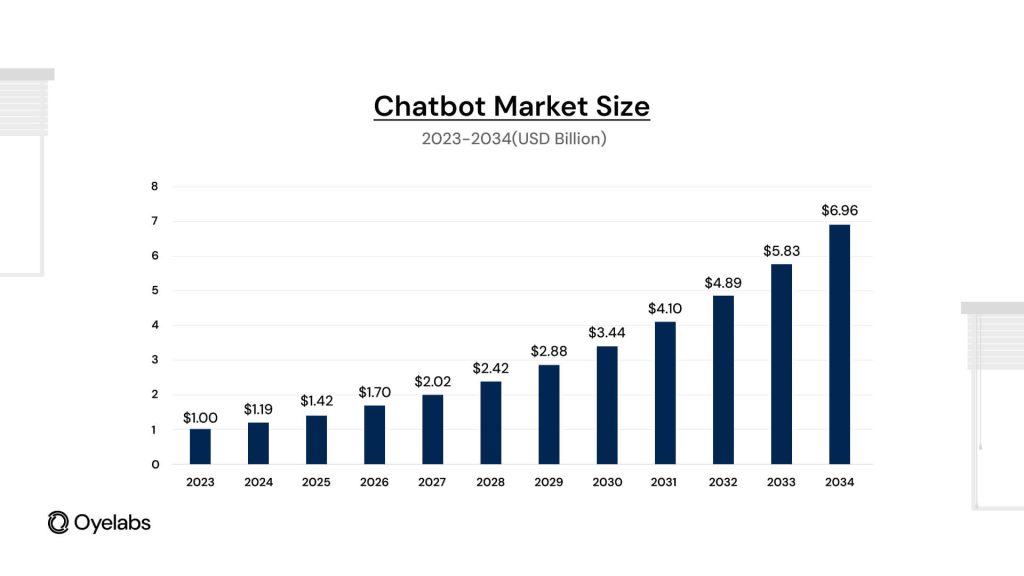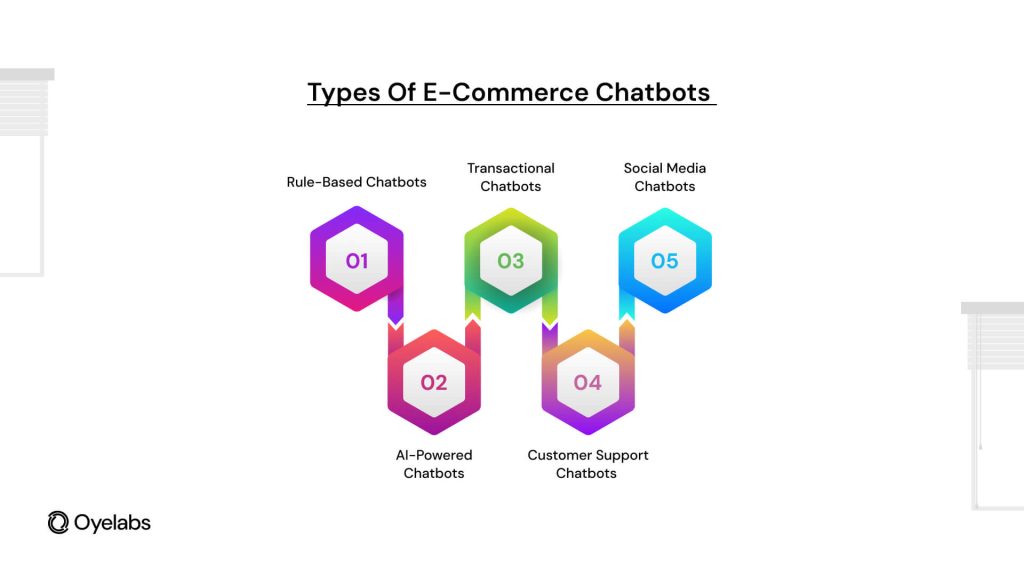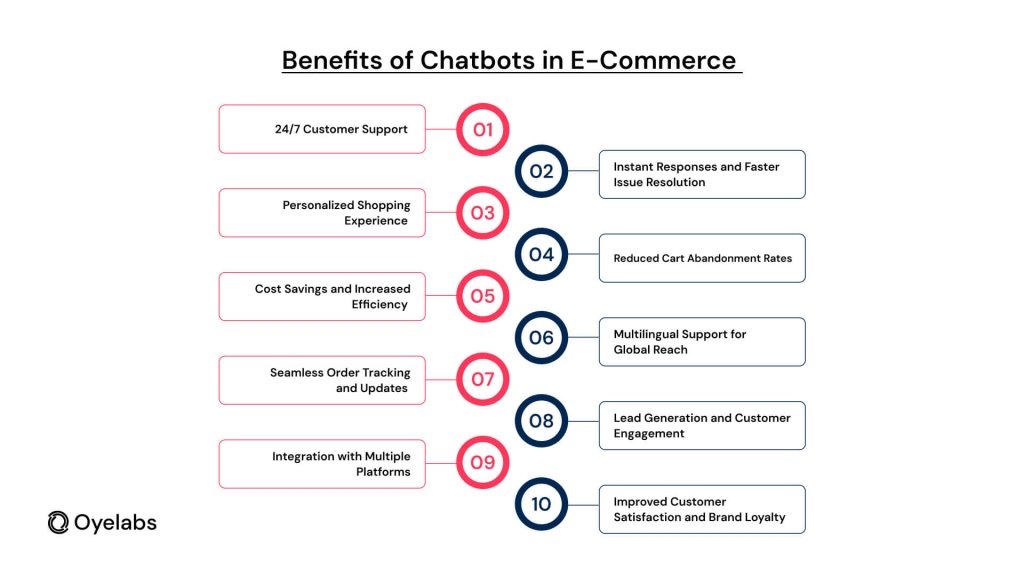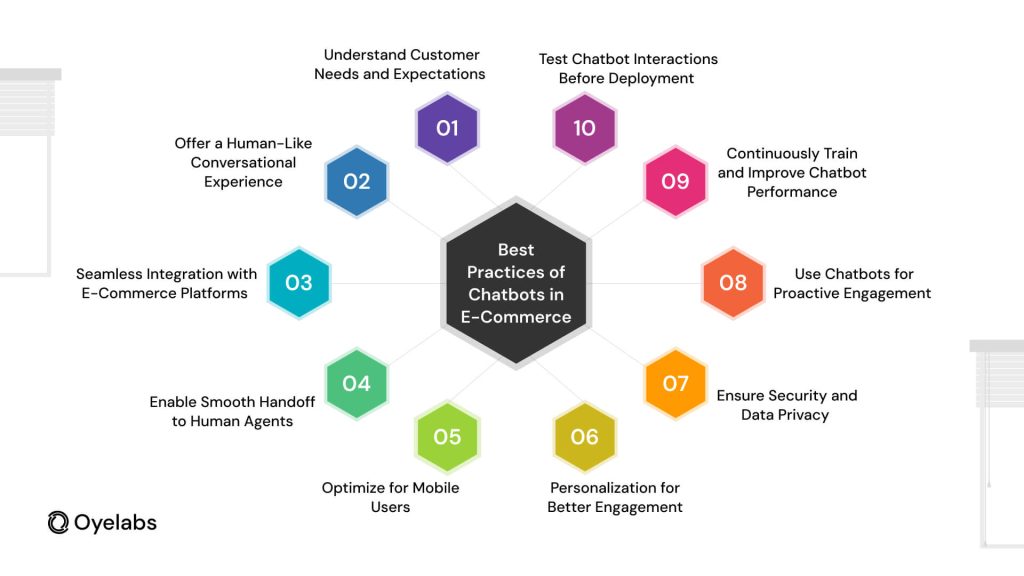Why are AI Chatbots Essential for your E-commerce Business
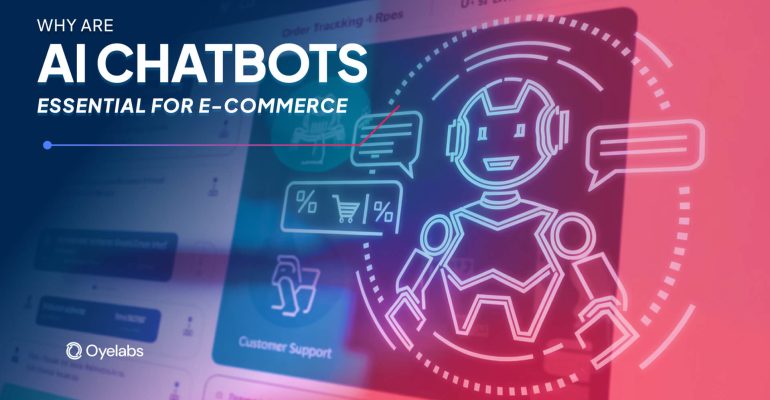
Why are AI Chatbots Essential for your E-commerce Business
Last Updated on February 27, 2025
In today’s fast-paced digital world, customers expect instant responses and seamless shopping experiences. Traditional customer support just doesn’t cut it anymore—people want answers now. That’s where AI chatbots step in.
AI-powered chatbots are revolutionizing e-commerce by offering 24/7 support, handling multiple queries at once, and providing personalized shopping assistance. Whether it’s answering FAQs, recommending products, or even processing orders, chatbots enhance customer experience while saving businesses time and money.
For Gen Z entrepreneurs and modern online store owners, integrating AI chatbots isn’t just an option—it’s a necessity. With the rise of conversational commerce, chatbots ensure that no potential sale is lost due to slow response times or poor engagement. They help scale businesses effortlessly, offering the kind of instant, interactive support that today’s shoppers expect.
If you want to grow your e-commerce brand and maximize customer satisfaction, it’s time to embrace AI chatbots.
Types of E-Commerce Chatbots
Rule-Based Chatbots
Rule-based chatbots operate using predefined decision trees and scripted responses. These chatbots follow a structured flow where users select options from menus or respond with specific keywords. They are ideal for handling frequently asked questions, such as order tracking, return policies, and store hours. While they provide quick and efficient support, they cannot understand natural language or handle complex queries. Businesses that require basic customer assistance without AI-driven conversations often use rule-based chatbots as a cost-effective solution. These chatbots are best suited for e-commerce stores with straightforward customer service requirements.
Also read: Agentic AI vs Generative AI: A Complete Guide
AI-Powered Chatbots
AI-powered chatbots use machine learning and natural language processing (NLP) to understand customer queries and provide intelligent responses. Unlike rule-based bots, they can interpret conversational language, making interactions more natural and engaging. AI chatbots continuously learn from customer interactions, improving their accuracy over time. They are ideal for businesses that receive diverse customer inquiries and require personalized engagement. AI-powered chatbots can recommend products based on browsing history, offer tailored promotions, and handle complex inquiries without human intervention. These chatbots significantly enhance customer experience by providing relevant, dynamic, and conversational support.
Transactional Chatbots
Transactional chatbots are designed to facilitate purchases directly within the chat interface. These bots allow customers to browse products, add items to their cart, and complete transactions without leaving the conversation. They integrate with e-commerce platforms and payment gateways, making the shopping process seamless. Transactional chatbots also assist with order modifications, refunds, and tracking updates. By reducing the number of steps required to make a purchase, they help businesses boost conversions and sales. Customers appreciate the convenience of completing transactions quickly, making these chatbots essential for online retailers looking to streamline the buying journey.
Also read: How Diffusion Models Are Shaping the Future of Generative AI?
Customer Support Chatbots
Customer support chatbots focus on resolving customer service-related issues such as troubleshooting product problems, processing returns, and answering FAQs. These chatbots help reduce the workload of human agents by handling routine inquiries, freeing up support teams to focus on more complex issues. They can also escalate cases to live agents when necessary, ensuring customers receive the assistance they need. With 24/7 availability, customer support chatbots enhance service efficiency and satisfaction. By providing instant responses, they reduce wait times and improve overall customer experience, making them indispensable for e-commerce businesses aiming to offer exceptional support.
Social Media Chatbots
Social media chatbots are designed to engage customers on platforms like Facebook Messenger, Instagram, and WhatsApp. These chatbots help businesses connect with their audience in real time, answer inquiries, and promote products. They can also assist with lead generation, customer feedback collection, and automated marketing campaigns. Social media chatbots enhance engagement by providing personalized interactions and responding instantly to user messages. With the rise of social commerce, integrating chatbots on these platforms helps businesses maximize conversions and build stronger relationships with their customers. They play a crucial role in modern e-commerce by making brand interactions more accessible and convenient.
Also read: AI in Sports: Revolutionizing Athletic Training and Performance
Benefits of Chatbots in E-Commerce
24/7 Customer Support
One of the biggest advantages of AI chatbots in e-commerce is their ability to provide round-the-clock customer support. Unlike human agents who work in shifts, chatbots are available 24/7 to assist customers, ensuring that no query goes unanswered, regardless of the time zone. This instant support enhances customer satisfaction, as shoppers no longer have to wait for hours or even days to get a response. Whether a customer needs help with order tracking, product recommendations, or return policies, chatbots can handle these queries efficiently.
Additionally, chatbots reduce the workload on customer service teams by filtering common issues and only forwarding complex cases to human agents. This results in faster resolution times and improved efficiency. By being always available, AI chatbots help businesses boost customer trust, retain more buyers, and ultimately increase sales. According to a report by IBM, AI can help businesses improve customer service metrics by up to 30%.
Instant Responses and Faster Issue Resolution
In a world where attention spans are shrinking, instant responses can make or break a sale. AI chatbots eliminate long waiting times by providing immediate answers to customer inquiries. Whether it’s a simple question about product availability or a more detailed query about shipping, chatbots can instantly fetch the relevant information. This reduces customer frustration and prevents potential buyers from abandoning their shopping carts.
Additionally, AI chatbots can handle multiple conversations simultaneously, unlike human agents who can only assist one customer at a time. This scalability ensures that businesses can manage high volumes of customer interactions, especially during peak shopping seasons. Faster issue resolution leads to a smoother shopping experience, helping businesses build stronger relationships with their customers and reducing the risk of losing sales due to slow response times.
Personalized Shopping Experience
AI chatbots are more than just automated responders—they are smart assistants capable of personalizing the shopping experience. By analyzing customer behavior, past purchases, and browsing history, chatbots can recommend products that align with a shopper’s preferences. This level of personalization makes the shopping journey more engaging and increases the chances of conversions. For instance, if a customer frequently buys skincare products, a chatbot can suggest new arrivals or complementary items. This targeted approach helps businesses boost sales while making customers feel valued.
Personalization also extends to chatbot interactions, as they can address customers by their names and remember past conversations, creating a more human-like experience. With Gen Z and millennial shoppers expecting tailored experiences, AI chatbots play a crucial role in making online shopping more intuitive and enjoyable. A study by PwC highlights that AI agents can reason, perform workflows, understand context, and generate creative solutions, thereby enhancing productivity and speed-to-market by over 50%.
Reduced Cart Abandonment Rates
Cart abandonment is a major challenge for e-commerce businesses, but AI chatbots can help tackle this issue effectively. Often, shoppers leave their carts due to unanswered questions, unexpected costs, or simply forgetting about their purchases. Chatbots can proactively engage with users who show signs of cart abandonment by offering assistance, answering queries, or even providing discounts. A simple prompt like, “Need help with your order?” can re-engage hesitant customers and encourage them to complete their purchase. Additionally, chatbots can send automated reminders to users who abandon their carts, nudging them to return and finalize the transaction. By addressing concerns in real time and offering incentives, chatbots help businesses recover lost sales and improve their conversion rates significantly.
Cost Savings and Increased Efficiency
Hiring and training a large customer service team can be expensive, but AI chatbots offer a cost-effective solution. By automating repetitive tasks, chatbots reduce the need for human intervention in handling basic queries, allowing businesses to allocate resources more efficiently. Instead of maintaining a large support team, companies can rely on AI chatbots to manage a majority of customer interactions, significantly lowering operational costs.
Additionally, chatbots streamline processes such as order tracking, FAQs, and returns, reducing the burden on employees and allowing them to focus on more complex tasks. This not only saves money but also enhances overall business efficiency. Small and medium-sized businesses, in particular, can benefit from chatbots as they provide enterprise-level support without the need for a massive customer service workforce.
Also read: Why Businesses Need a Custom AI Copilot – Benefits & Use Cases
Multilingual Support for Global Reach
E-commerce is no longer limited to a single country or region—businesses now cater to a global audience. However, language barriers can be a significant challenge when engaging with international customers. AI chatbots equipped with multilingual capabilities can bridge this gap by communicating with users in their preferred language. Whether a customer speaks English, Spanish, French, or Chinese, chatbots can provide accurate translations and seamless interactions. This feature not only enhances customer experience but also expands a business’s potential market. With more consumers feeling comfortable shopping in their native language, companies can increase their international sales and build stronger relationships with a diverse customer base. By offering multilingual support, AI chatbots ensure inclusivity and accessibility, making e-commerce truly global.
Also read: How to Build an AI Copilot for Enterprises – Complete Guide
Seamless Order Tracking and Updates
Customers often have concerns about their orders—when will they be shipped, where are they currently, and when will they arrive? AI chatbots simplify this process by providing instant order tracking updates. Instead of searching through emails or logging into accounts, shoppers can simply ask the chatbot for their order status and receive real-time information. Chatbots can also send automated notifications about order confirmations, shipping details, and delivery estimates, keeping customers informed at every step. This proactive approach reduces customer anxiety and minimizes the need for support calls or emails. By offering real-time tracking, businesses can enhance customer trust and satisfaction, ensuring a smoother post-purchase experience.
Lead Generation and Customer Engagement
AI chatbots are not just for customer support—they are also powerful tools for lead generation and engagement. By initiating conversations with website visitors, chatbots can capture potential customers’ contact details, qualify leads, and even guide them toward making a purchase. For example, a chatbot can ask visitors if they need help finding a product and then direct them to relevant options based on their preferences.
Additionally, chatbots can engage users through interactive elements like quizzes, surveys, and promotional offers, making the shopping experience more engaging. With the ability to collect valuable customer data, businesses can refine their marketing strategies and target leads more effectively. This proactive approach ensures higher conversions and long-term customer retention. According to eMarketer, AI-powered programmatic advertising accounts for over 80% of digital display ad spending.
Integration with Multiple Platforms
Modern shoppers don’t just browse a website—they interact with brands across multiple platforms, including social media, messaging apps, and email. AI chatbots can be integrated into these platforms, providing seamless customer support wherever shoppers prefer to communicate. Whether on Facebook Messenger, WhatsApp, Instagram, or a business’s website, chatbots offer a unified experience across all channels. This omnichannel support ensures that businesses can engage with customers wherever they are, improving accessibility and convenience. With social commerce on the rise, integrating chatbots into various platforms enhances brand presence and increases sales opportunities.
Improved Customer Satisfaction and Brand Loyalty
At the core of every successful e-commerce business is a loyal customer base. AI chatbots help improve customer satisfaction by providing quick, accurate, and personalized support. When customers feel heard and valued, they are more likely to return and recommend the brand to others. Chatbots also enhance loyalty by sending personalized offers, follow-up messages, and exclusive deals to repeat customers. By maintaining continuous engagement and offering a seamless shopping experience, businesses can foster long-term relationships with their customers. Ultimately, satisfied customers become brand advocates, contributing to increased sales and business growth.
Also read: Building AI-Powered Recommendation System – A Complete Guide
Best Practices of Chatbots in E-Commerce
Understand Customer Needs and Expectations
Before implementing a chatbot, it is crucial to understand your customers’ needs and expectations. A well-designed chatbot should cater to common customer queries, provide relevant product recommendations, and offer support for order tracking and returns. Conducting customer surveys, analyzing previous interactions, and studying user behavior can help identify the most frequent concerns shoppers have. Chatbots should be trained using real customer data to ensure they provide accurate and helpful responses. Additionally, businesses should continuously update their chatbot’s knowledge base to reflect changes in product offerings, policies, and industry trends. A chatbot that truly understands customer pain points will improve user satisfaction and lead to higher engagement, making it an essential asset for any e-commerce business.
Offer a Human-Like Conversational Experience
One of the best practices for chatbot implementation is ensuring the conversation feels natural and engaging. Shoppers are more likely to interact with a chatbot that mimics human conversation rather than one that sounds robotic or scripted. This can be achieved by using a friendly tone, incorporating emojis, and allowing the chatbot to handle small talk. Additionally, the chatbot should be programmed to recognize different phrasings of the same question to avoid frustrating users with rigid responses. AI-powered chatbots that utilize Natural Language Processing (NLP) can understand context, sentiment, and intent, making interactions smoother. Providing personalized greetings, remembering past interactions, and addressing customers by name enhances the experience, fostering a sense of connection and trust.
Also read: Why ERP AI Chatbots Are a Game-Changer for your Businesses?
Seamless Integration with E-Commerce Platforms
A chatbot should seamlessly integrate with an e-commerce store’s website, mobile app, and social media channels. Customers interact with businesses through multiple touchpoints, and chatbots must be available on all platforms where users engage. Integrating chatbots with popular e-commerce platforms like Shopify, WooCommerce, and Magento ensures a smooth shopping experience. Additionally, chatbots should sync with inventory management systems to provide real-time updates on product availability. They should also connect with CRM and email marketing tools to personalize promotions based on customer preferences. A well-integrated chatbot can drive higher engagement, automate sales processes, and offer uninterrupted assistance, making it a crucial element of modern e-commerce strategies.
Enable Smooth Handoff to Human Agents
While chatbots can handle a majority of customer inquiries, some issues require human intervention. A best practice is to ensure a smooth transition from chatbot to human agents when necessary. Customers should not feel trapped in a loop of automated responses when they need personalized assistance. Businesses should implement a chatbot system that recognizes complex or sensitive queries and offers an option to connect with a live agent. The chatbot should provide context to human agents, including chat history, customer details, and issue summaries, ensuring a seamless transition. This hybrid model improves efficiency and customer satisfaction by combining AI automation with human expertise.
Also read: AI in Gaming: How Artificial Intelligence is Changing the Industry
Optimize for Mobile Users
With a growing number of shoppers using mobile devices, optimizing chatbots for mobile is essential. The chatbot interface should be user-friendly, responsive, and easy to navigate on smaller screens. Messages should be concise, with quick-reply buttons to simplify interactions. Businesses should also ensure that chatbots are integrated with mobile messaging apps such as WhatsApp, Facebook Messenger, and Instagram DMs to cater to users who prefer social commerce. A mobile-optimized chatbot enhances customer convenience, allowing them to shop, track orders, and receive support from anywhere, anytime. Prioritizing mobile-friendliness ensures that businesses cater to the needs of on-the-go consumers, maximizing engagement and conversions.
Personalization for Better Engagement
AI-powered chatbots should be designed to provide a personalized experience for each user. By leveraging customer data, chatbots can offer product recommendations based on past purchases, browsing history, and preferences. Personalization can also extend to greetings, order tracking updates, and exclusive discounts tailored to individual customers. Implementing AI-driven personalization helps businesses increase customer retention and boost sales. Additionally, offering dynamic responses that adapt based on the context of the conversation makes interactions more relevant. A chatbot that remembers user preferences and provides a customized experience creates a more engaging shopping journey, ultimately leading to higher customer satisfaction and loyalty.
Also read: The Role of AI in Business Intelligence (BI) in 2025
Ensure Security and Data Privacy
E-commerce businesses must prioritize security and data privacy when deploying chatbots. Customers share sensitive information, such as payment details and personal data, during interactions. Implementing encryption protocols, multi-factor authentication, and compliance with data protection regulations like GDPR ensures that customer data remains secure. Chatbots should also be transparent about their data collection practices, informing users about how their information will be used. Providing an option to opt out of data collection and ensuring that chat logs are securely stored minimizes security risks. A secure chatbot instills confidence in customers, enhancing trust and long-term engagement.
Use Chatbots for Proactive Engagement
Rather than waiting for customers to ask questions, chatbots should proactively engage users by offering assistance, recommendations, and promotional offers. For instance, a chatbot can greet returning visitors with a personalized message, suggest trending products, or notify them about ongoing discounts. Additionally, chatbots can remind customers about abandoned carts, encouraging them to complete their purchases by offering limited-time discounts. Proactive engagement ensures that businesses capitalize on potential sales opportunities while making the shopping experience more interactive. A well-timed chatbot interaction can significantly enhance conversion rates and encourage repeat purchases.
Also read: How to Choose the Right AI Consulting Partner
Continuously Train and Improve Chatbot Performance
AI chatbots require ongoing training and improvement to stay effective. Businesses should analyze chatbot interactions to identify common pain points and areas where responses need refinement. Implementing machine learning algorithms allows chatbots to improve over time by learning from past conversations. Regular updates should be made to the chatbot’s database, incorporating new FAQs, product details, and customer feedback. Monitoring chatbot analytics, such as response accuracy, user satisfaction rates, and conversion metrics, helps optimize performance. By continuously enhancing chatbot capabilities, businesses can ensure they provide top-tier customer support and engagement.
Test Chatbot Interactions Before Deployment
Before launching a chatbot, businesses should conduct thorough testing to identify potential errors and inefficiencies. Testing should include different scenarios, such as customer inquiries, product searches, order tracking, and complaint resolutions. Conducting A/B testing with different chatbot versions helps determine which responses most effectively engage customers. Additionally, businesses should gather feedback from test users to refine the chatbot’s tone, functionality, and usability. A well-tested chatbot ensures a smooth user experience, reducing the likelihood of customer frustration due to incorrect or irrelevant responses. Businesses can deploy a chatbot that meets customer expectations and delivers a high-quality shopping experience by prioritizing testing and refinement.
Also read: Top 8 Pros and Cons of AI Agents in Marketing for Business
Launch your E-Commerce Chatbots with Oyelabs
Are you ready to take your e-commerce business to the next level? Oyelabs offers cutting-edge AI-powered chatbot solutions tailored to enhance customer experience, boost sales, and automate support. Our chatbots seamlessly integrate with your e-commerce platform, providing 24/7 assistance, personalized recommendations, and real-time order tracking. Whether you need a rule-based chatbot, an AI-driven assistant, or a transactional chatbot, Oyelabs has the perfect solution for your business. With our expertise, you can streamline operations, improve engagement, and drive conversions effortlessly. Elevate your brand with intelligent chatbot solutions—partner with Oyelabs today and revolutionize the way you interact with your customers. Get started now and experience seamless automation for your online store!
Conclusion
AI chatbots are essential for e-commerce because they enhance customer experience, streamline operations, and boost sales. They provide 24/7 support, personalized recommendations, and instant responses, improving customer satisfaction and retention. Chatbots also automate order tracking, FAQs, and payment assistance, reducing workload and operational costs. By leveraging AI-driven insights, businesses can optimize marketing strategies and drive conversions. As e-commerce grows, integrating AI chatbots is no longer a luxury but a necessity for staying competitive.
Ready to elevate your e-commerce business with AI chatbots? Contact Oyelabs today and revolutionize your customer experience!
